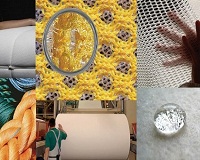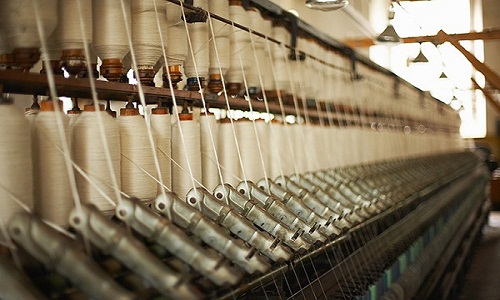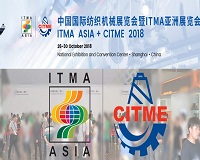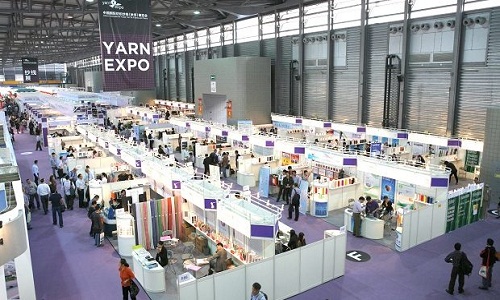FW
In order to build a sustainable brand for Vietnamese textiles, the Vietnam Textile and Apparel Association (VITAS), the Sustainable Apparel Coalition (SAC) and Hong Kong-based garment firm TAL Group have decided to introduce the HIGG index in the country’s textile and garment industry.
An online self-assessment tool, the HIGG index standardises measures for environmental and social impacts in the textile, footwear and fashion industries. It is a standard sustainable report tool used globally by more than 8,000 manufacturers and 150 brands. Nearly 70 per cent of the businesses in Vietnam are familiar with the index, but only 20.8 per cent of them have tried it, a preliminary survey of more than 200 enterprises revealed.
According to SAC CEO Jason Kibbey, HIGG is a necessary benchmark as enterprises buying raw materials for production and selling products to the United States and EU countries needed the index. (DS)
"Global technical textile imports are dominated by the US with 17 per cent share; followed by China, Germany and UK with 10 per cent, 8 per cent and 4 per cent, share respectively. The rest of the world accounts for 40 per cent in technical textiles imports. Emerging regions such as the Asia-Pacific and Latin America are presumed to witness rapid growth in multiple segments of technical textiles. China is the largest exporter of technical textile with a share of 24 per cent, followed by the US, Germany, and Republic of Korea with a share of 10 per cent, 9 per cent and 4 per cent respectively."
 Touted as the sunrise segment for textile industry, technical textile has the potential to bring fortunes for Indian textile industry. Despite achieving high growth rate, the per capita consumption of technical textiles in India is 1.7 per kg vis-a-vis 10-12 kg in developed countries. As per estimates, global market for technical textiles is estimated at $145 billion in 2015 and is expected to grow at a CAGR of 4 per cent and reach $170 billion by 2020. Demand for technical textiles will be driven by rapid industrialisation, robust growth in construction and infrastructure projects, increasing automobile production, and rising demand from the health care sector.
Touted as the sunrise segment for textile industry, technical textile has the potential to bring fortunes for Indian textile industry. Despite achieving high growth rate, the per capita consumption of technical textiles in India is 1.7 per kg vis-a-vis 10-12 kg in developed countries. As per estimates, global market for technical textiles is estimated at $145 billion in 2015 and is expected to grow at a CAGR of 4 per cent and reach $170 billion by 2020. Demand for technical textiles will be driven by rapid industrialisation, robust growth in construction and infrastructure projects, increasing automobile production, and rising demand from the health care sector.
Global technical textile imports are dominated by the US with 17 per cent share; followed by China, Germany and UK with 10 per cent, 8 per cent and 4 per cent, share respectively. The rest of the world accounts for 40 per cent in technical textiles imports. Emerging regions such as the Asia-Pacific and Latin America are presumed to witness rapid growth in multiple segments of technical textiles. China is the largest exporter of technical textile with a share of 24 per cent, followed by the US, Germany, and Republic of Korea with a share of 10 per cent, 9 per cent and 4 per cent respectively.
India story
Indian technical textile market is slated to grow till 2024 and the market is expected to reach Rs 1,16,217 crore (approx $US 17 bn) till 2017-18, from Rs 65,920 crores (approx $US 9.63 bn) in 2012-13 at a CAGR of 12 per cent. Packtech is the largest segment with 43 per cent share of the market, followed by Mobiltech, Indutech, and hometech with a share of 11 per cent, 10 per cent and 10 per cent, respectively. Indutech, Packtech, and Hometech are the largest exported segments having a combined share of around 85 per cent in the total exports of technical textiles. Higher focus on these commodity products is due to the fact that these products require low investments and there is an absence of the required technology and specialty fibers which are required in the manufacturing of advanced technical textile products.
65,920 crores (approx $US 9.63 bn) in 2012-13 at a CAGR of 12 per cent. Packtech is the largest segment with 43 per cent share of the market, followed by Mobiltech, Indutech, and hometech with a share of 11 per cent, 10 per cent and 10 per cent, respectively. Indutech, Packtech, and Hometech are the largest exported segments having a combined share of around 85 per cent in the total exports of technical textiles. Higher focus on these commodity products is due to the fact that these products require low investments and there is an absence of the required technology and specialty fibers which are required in the manufacturing of advanced technical textile products.
India has a greater scope of becoming a global hotspot for technical textiles. The reasons are many: Abundant availability of textile raw materials; technical textiles being labour-intensive industry, the presence of the large pool of labour at a comparatively low cost in India vis-à-vis other technical textile producing countries like China, US, EU etc. provides India a competitive standing; power costs in India are lower than countries like China & Germany and comparable to low-cost destinations like Bangladesh, Vietnam, Myanmar, Kenya, etc.; developing infrastructural for technical textiles in India, etc.
The segment needs work on issues such as absence of regulatory measures for technical textile usage in infrastructure, construction, etc.; dependence on import for technology and machinery; limited production of high-end products and specialized yarns and intricate duty structures. Suggestive measures include: establishing regulatory norms for mandatory usage of technical textile items in specific industries to increase their consumption, developing exclusive HSN codes for identifying high growth products for further development, establishing and implementing Indian standards for developing high quality products of global acceptance, improvement of operational standards, focus on training and education and creating end user awareness for increasing domestic demand for high end technical textile products. Additionally, partnerships with global players for acquiring technical know-how, the creation of mega parks to attract large-scale investments and focus on R&D initiatives will also bear fruit in the long run.
"The scale and importance of China International Import Expo (CIIE) – an initiative launched personally by Chinese President Xi Jinping at a Belt & Road Forum in 2017 and hosted by the country’s Ministry of Commerce – has necessitated the renovation of three halls at the National Exhibition and Convention Center for two months starting early September. The unavailability of the full fairground has led to the decision of moving Yarn Expo Autumn two weeks later to October 15-17. Therefore, this year, Yarn Expo Autumn will now not be held at the same time as Intertextile Shanghai Apparel Fabrics-Autumn edition rather it will take place concurrently with the biennial ITMA Asia + CITME which runs for two extra days until October 19."
 The scale and importance of China International Import Expo (CIIE) – an initiative launched personally by Chinese President Xi Jinping at a Belt & Road Forum in 2017 and hosted by the country’s Ministry of Commerce – has necessitated the renovation of three halls at the National Exhibition and Convention Center for two months starting early September. The unavailability of the full fairground has led to the decision of moving Yarn Expo Autumn two weeks later to October 15-17. Therefore, this year, Yarn Expo Autumn will now not be held at the same time as Intertextile Shanghai Apparel Fabrics-Autumn edition rather it will take place concurrently with the biennial ITMA Asia + CITME which runs for two extra days until October 19.
The scale and importance of China International Import Expo (CIIE) – an initiative launched personally by Chinese President Xi Jinping at a Belt & Road Forum in 2017 and hosted by the country’s Ministry of Commerce – has necessitated the renovation of three halls at the National Exhibition and Convention Center for two months starting early September. The unavailability of the full fairground has led to the decision of moving Yarn Expo Autumn two weeks later to October 15-17. Therefore, this year, Yarn Expo Autumn will now not be held at the same time as Intertextile Shanghai Apparel Fabrics-Autumn edition rather it will take place concurrently with the biennial ITMA Asia + CITME which runs for two extra days until October 19.
A change of date
“The unavailability of halls was unforeseen but upon notice from the fairground, we assessed all possible alternatives for hosting the fair. While it is unfortunate that for this edition, it will not be taking place concurrently with Intertextile Shanghai Apparel Fabrics, we are confident that the same strong business results can still be achieved alongside ITMA ASIA + CITME. With over 1,600 textile machinery manufacturers and some 100,000 trade buyers from different textile sectors taking part in ITMA ASIA + CITME, Yarn Expo exhibitors will have abundant opportunities to meet buyers of apparel fabrics and home textiles as well as garment manufacturers,” informed Wendy Wen, senior general manager, Messe Frankfurt (HK) Ltd.
Yarn Expo Autumn is Asia’s leading trade platform for the yarn and fibre industry, with quality suppliers from around the world showcasing natural and blended yarns including cotton, wool, flax, and man-made fibres and yarns, as well as specialty products including elastic, fancy and blended yarns. Last year’s Autumn Edition attracted 493 exhibitors from 13 countries and regions, and 17,185 trade buyers from 84 countries and regions. The fair is organised by Messe Frankfurt (HK) Ltd and the Sub-Council of Textile Industry, CCPIT.
blended yarns including cotton, wool, flax, and man-made fibres and yarns, as well as specialty products including elastic, fancy and blended yarns. Last year’s Autumn Edition attracted 493 exhibitors from 13 countries and regions, and 17,185 trade buyers from 84 countries and regions. The fair is organised by Messe Frankfurt (HK) Ltd and the Sub-Council of Textile Industry, CCPIT.
The UK fashion market has fallen in value terms by 0.4 per cent. This mark the eighth consecutive period of flat or negative growth. The last time the British fashion market – covering clothing, footwear and accessories – experienced more than one month of growth in a row was two years ago, in June 2016.
Shopping frequency is down by one trip per year, which makes a significant difference across the whole population. Turning this around will be the next big test for retailers. Unless things change, current market projections suggest a one per cent decline in the market this time next year.
Two-thirds of clothing, footwear and accessories sold in the past year were at full price, though the value of these sales fell by 443 million pounds. Discounted clothing grew by 303 million pounds in the same period though both full price and discount items saw declines in the number of units sold – down by one million and 31 million respectively, showing that discounting is not increasing the amount that shoppers buy.
Heavy discounting favored by many high street retailers still isn’t having the desired effect in terms of driving spends or footfalls. Shoppers today are buying in the moment and retailers have to be much more flexible and fleet of foot to accommodate this.
The Taiwan Textile Federation (TTF) is promoting sustainability, technological innovation and new functional textiles at Technotex India. Targeting the growing Indian technical textile industry, expected to grow 20 per cent annually to touch $30 billion in five years, Technotex is a global platform to explore opportunities in India.
Exploring new partnerships and business opportunities in the growing technical textiles sector of India, this year 10 leading Taiwanese companies producing innovative technical, functional, performance and industrial textiles and accessories will be showcasing their high-end products along with others at the two-day exhibition. This will be an excellent opportunity for Indian buyers to network with the Taiwanese suppliers.
Technotex India is organized by the ministry of Textiles in association with FICCI. Taiwan’s textile manufacturers will surf the wave at the exhibition by catering to the wellness generation, getting the production more cost-effective and going greener.
Technotex is an important platform to showcase and promote Taiwan’s strength in technical as well as functional textiles amongst the Indian buyers across various industry verticals. It is looking forward to build new contacts and explore business opportunities in the Indian technical textiles market as well as other sectors such as sports apparel, outdoor gear and wear, home textiles and medical and healthcare sectors says Sean Tsai of Taiwan Textile Federation.
The trade war between the US and China is expected to benefit Pakistan’s textile sector. It has come as a boon to Pakistani textile exporters as despite poor crop quality and lower domestic cotton production, garment manufacturers are expected to benefit from lower prices of imported cotton.
Already, the domestic textile value add sector is enjoying a great run on the back of the currency depreciation and the resultant price competitiveness of Pakistani manufactured goods in the global market. On import side, increased cost of imported raw cotton due to higher dollar rates is expected to be more than offset by the lower commodity price in the global market.
The US is one of the largest producers of cotton and the imposition of tariffs is expected to put a downward pressure on its raw cotton exports. Already, cotton prices have declined by 75 cents per pound during last week’s future trading. The obvious beneficiaries of the supply glut are net importers such as Bangladesh, Turkey and Vietnam who continue to rely heavily on imported long staple cotton for higher thread count yarn. Exporters like India will also gain some benefit, as Chinese textile manufacturers look elsewhere for raw material.
The Seam a global commodities trading and agri-business software solutions provider, has formed the Cotton Technology Alliance in cooperation with the American Cotton Shippers Association, National Cotton Council and International Cotton Association. The organization held its first official meeting on June 26. The Association is focused on data standards, which will have a confident impact on all sectors of the cotton industry.
The Cotton Technology Alliance will offer a neutral forum allowing industry software experts to work together by describing, spreading and contributing to data standards, explore emerging technologies and communicate more closely around industry and regulatory changes.
Cargill, Dunavant, EWR, Louis Dreyfus Company, Mallory Group, PCCA, The Seam, Staplcotn, Three Rivers Cotton Systems, USDA AMS Cotton and Tobacco Program, and Wakefield Inspection Services are few of the initial member companies of the Alliance. The Alliance formation accords with The Seam’s recent website renovation, which features info on the company’s products ranging from custom software for agriculture and commodities trading to blockchain initiatives, as well as a broadcasting studio reporting on the latest trends within the industry.
The Seam was founded by leading global agribusinesses and specializes in software development for commodity trading and management systems. The company has leveraged its software and development expertise in agriculture to expand into other commodity segments.
The Sri Lanka Apparel Brands Association [SLABA] will once again organise SLABA Runway 2018, featuring top Sri Lankan apparel brands who will showcase their designs at a glitzy ramp extravaganza. The runway will be spearheaded by a dynamic committee, headed by Azam Habib, President SLABA, Tania Abeysundara, Chairman Organising Committee SLABA Runway 2018 and Shakir Hafiz, Treasurer, SLABA, ably assisted by the rest of the SLABA membership.
The SLABA membership has over 60 members including Reborn, EKKO, Emerald, Signature, Manzari , Trendy, Rough, Arista , LiCC Jeans, Rainco, JEZZA, Avirate, GFlock, Dmaxx, Aurora, Anationz, Perri Allen , Vantage , Uptown Kandy, Andre, etc. They will showcase their brands which have brought in valuable foreign exchange to the country whilst entrenching Sri Lanka in the minds of global apparel buyers as a destination renowned for the production of quality apparel.
SLABA operates as a facilitator in developing the apparel brands segment in Sri Lanka and the membership body. It works together closely with the government of Sri Lanka and non-government organisations such EDB, Chamber of Commerce, and JAFF to develop the industry as well as explore and access new markets.
HGH India 2018, India’s largest trade-show for home textiles, home décor, houseware and gifts – designed exclusively for the professional and trade visitors – presented latest trends in home fashion and lifestyle in Mumbai. Conceptualised and implemented by the internationally renowned design office Sahm + Permantier, the trends, under the title ‘Transition’,reflect the influence of social, lifestyle and technological changes in the Indian home products market in 2018 – 19.
The trends are derived from intense research on colours, materials and patterns as well as on changing consumer values, lifestyle, evolving technology and attitudes. These help manufacturers, brands, retailers and professionals in home business to connect their products and innovations to the aspirational Indian consumers. The Four Trends for 2018-19 are: So Funky at Home, Soft shades of Nature, Collector's Chamber, Smart Bohemians
The trends forecasted in ‘Transition’ are also compiled in a trend book. They will be physically manifested at a generously dimensioned special area in HGH India 2018 named the Trends Pavilion in Hall 1. The pavilion will have applicable designs and colours which can be replicated. The innovative and fashionable styles, textures and products used in the trends pavilion are sourced from exhibitors, who will showcase their products at the trade show, emphasising the utilitarian objective of the showcased trends.
HGH India 2018 is India’s largest trade show for home textiles, home décor, houseware and gifts. The next edition will be held at the Bombay Exhibition Centre from July 3-5, 2018. The trade show will house products from over 600 brands and manufacturers from 30 countries.It expects a footfall of 30,000 serious trade visitors from over 475 cities and towns across India..
For the fourth quarter Nike’s revenue increased 13 per cent. Diluted earnings per share rose 15 per cent. Gross margin increased 60 basis points to 44.7 per cent. Selling and administrative expense increased 17 per cent. Demand creation expense was up 25 per cent. Operating overhead expense increased 14 per cent.
The effective tax rate was 6.4 per cent, compared to 13.7 per cent for the same period last year. Net income increased 13 per cent. For the full year gross margin decreased 80 basis points to 43.8 per cent. Selling and administrative expense increased nine per cent. Demand creation expense was up seven per cent. Operating overhead expense rose ten per cent. The effective tax rate was 55.3 per cent, compared to 13.2 per cent in fiscal 2017. Net income decreased 54 per cent. Diluted earnings per share decreased 53 per cent.
Fueled by a complete digital transformation of the company end-to-end, this year set the foundation for Nike’s next wave of long-term, sustainable growth and profitability. US-based brand Nike is the world’s leading designer, marketer and distributor of authentic athletic footwear, apparel, equipment and accessories for a wide variety of sports and fitness activities. Subsidiary brands include Converse, which designs, markets and distributes athletic lifestyle footwear, apparel and accessories; and Hurley, which designs, markets and distributes surf and youth lifestyle footwear, apparel and accessories.












